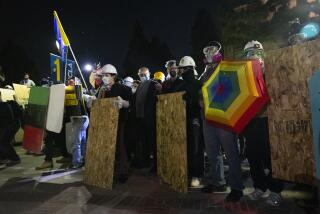Chernobyl Is Everywhere : CHERNOBYL A Russian Journalistâs Eyewitness Account <i> by Andrey Illesh (Richardson & Steirman: $18.95; 200 pp., illustrated) </i>
When two explosions ripped through Unit 4 of the Chernobyl nuclear energy complex in the early hours of April 23, 1986, along with the radioactive debris, scores of conflicting interpretations about causes, consequences and remedies emerged in the media. Definitive answers to the mystifying events only appeared upon Soviet publication of an extensive technical evaluation in August, 1986. Coupled to subsequent studies by the International Atomic Energy Agency and the U.S. government, we now can trace minute by minute the course of the mishap. Ironically, its roots lay in operator negligence in testing safety systems.
While these technical reports provide an invaluable record, they fail to capture the human drama. Chernobyl was not merely another industrial accident. To be sure, the immediate injury and loss of life--31 died; several hundred hospitalized--was not monumental. It cannot, for example, compare to Bhopal, where several thousand succumbed immediately to a chemical accident. But Chernobyl was different and more frightening to the world at large. It tapped manâs fear of the nuclear weapons abyss. The radioactive plume knew no boundary. Monitors detected âhot spotsâ across Europe. Public health authorities embargoed contaminated foodstuffs. Children were told to stay indoors. Mothers aborted their fetuses. In many circles, panic was the order of the moment. Even today, a year and a half later, the effects of Chernobyl are still with us. The exclamation of the time--âChernobyl is everywhereâ--seems apropos: Of the thousands of cancers that may emerge in the accidentâs wake, some analysts predict half will appear outside the Soviet Union.
The real drama, of course, did not take place outside. The frontline was the Ukrainian countryside. And, while the Russian media were less than candid during the accident, in its aftermath, stories of heroism and cowardice appeared. Still we lacked a definitive review of what it was really like in those dark days of spring. Andrey Illeshâs reporterâs âeyewitness account,â âChernobyl,â is one such effort.
I approached the book with great anticipation. Having studied the accident thoroughly at a distance, I hoped it would help me better understand what took place. Alas, except for a few new vignettes and about 77 photos of the reactor and decontamination efforts, some not published heretofore, I was disappointed.
Divided into 11 short chapters, the author begins by casting aspersions upon the Western media for lacking integrity and empathy in reporting the early days of the accident. The critique has merit up to a point: There was a lot of hype; mistakes were made. However, matters were hardly helped by either the unwillingness or inability of the Soviets to get the real story out.
Much of the book is a chronology of accident. Interspersed are personal stories of those who sought to slay a nuclear dragon. Technical flaws mar the explanation. For example, in bold print, we are told that the reactor operated without a working emergency core cooling system. By implication, the oversight contributed to the accident. In fact, it made no difference. What the disengagement demonstrated was managerial sloppiness, nothing more in this case.
But it is not science that one should look to in a book of this sort. It is the human story that counts--the actions of ordinary people, rescuers, and decision makers both near and far. In this regard, the book is a lame attempt at investigative journalism. To convey the stress of the moment, Illesh reproduces all too brief interviews--a few nondescript paragraphs--of firemen and helicopter pilots. He reconstructs the evacuation and relocation of more than 100,000 people near the plant, the stories of a few of the injured, decontamination of the surrounding countryside and the concrete encasement of the reactor to contain residual releases of radiation.
Almost entirely absent from the book is mention of what took place in the Kremlin. Clearly the accident must have been one of the greatest challenges of the young Gorbachev regime--or any recent Soviet leadership for that matter. Yet we learn nothing of its ordeal as it sought to mobilize an extraordinary national effort to contain the accident. Nor are the real blemishes of the Soviet response elaborated. For example, accounts in the Baltic press that soldiers from the region were dragooned to clean up the contamination are nowhere to be seen.
In the aftermath of the Three Mile accident, several excellent books detailing the course of events, the actions--both the good and the bad--of officials on the scene and in Washington, and the behavior of ordinary residents appeared in print. As a result, we now have a rather good idea of what took place. Unfortunately, Illeshâs âChernobylâ does not live up to this standard of investigative journalism. At best, it is a modest contribution to our knowledge. We still must await the accounts by others to fill in the details.
More to Read
Sign up for Essential California
The most important California stories and recommendations in your inbox every morning.
You may occasionally receive promotional content from the Los Angeles Times.










